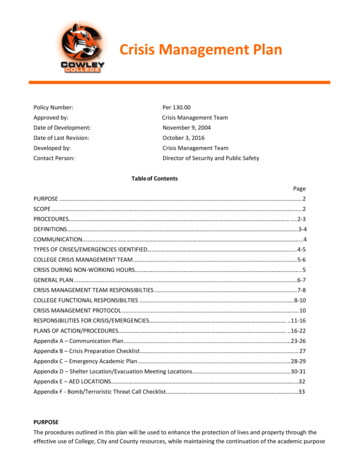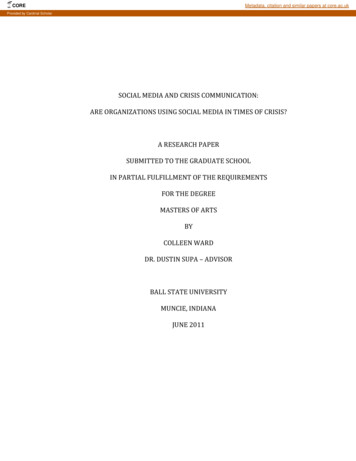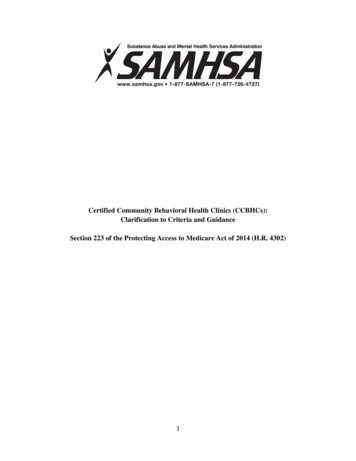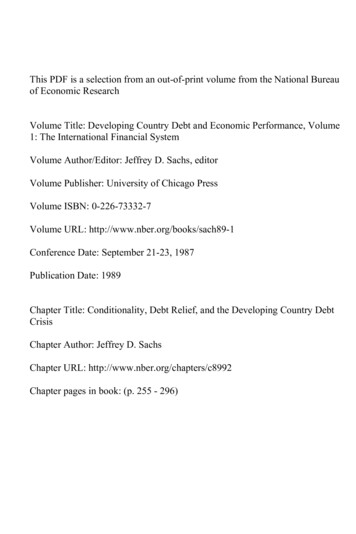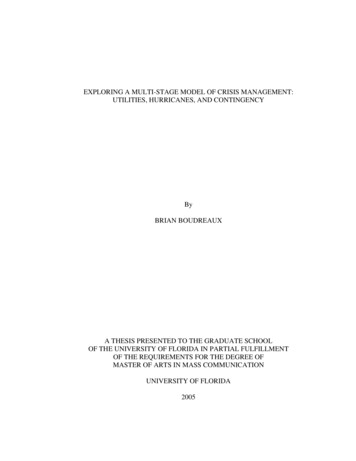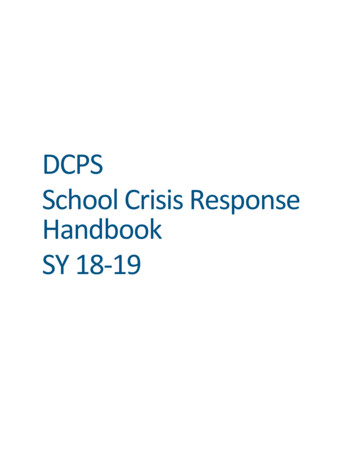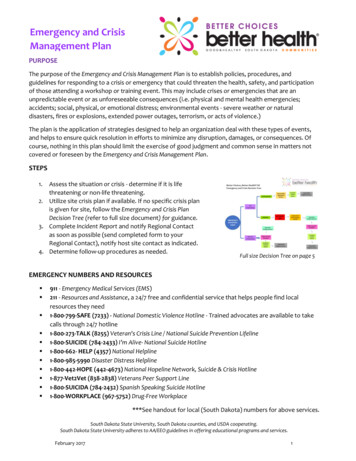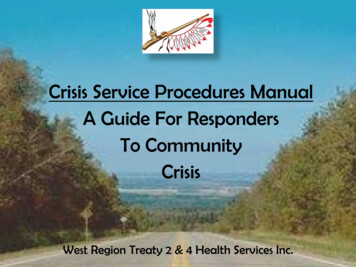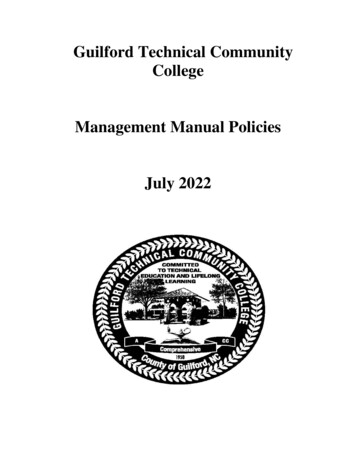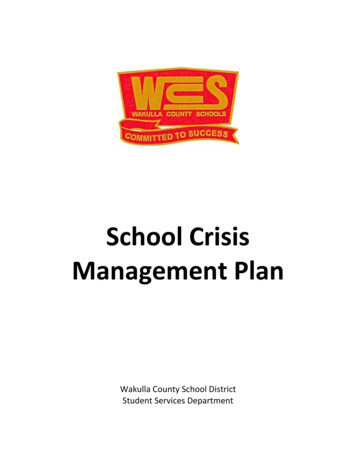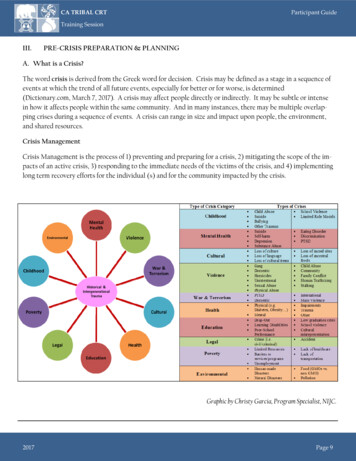
Transcription
CA TRIBAL CRTParticipant GuideTraining SessionIII.PRE-CRISIS PREPARATION & PLANNINGA. What is a Crisis?The word crisis is derived from the Greek word for decision. Crisis may be defined as a stage in a sequence ofevents at which the trend of all future events, especially for better or for worse, is determined(Dictionary.com, March 7, 2017). A crisis may affect people directly or indirectly. It may be subtle or intensein how it affects people within the same community. And in many instances, there may be multiple overlapping crises during a sequence of events. A crisis can range in size and impact upon people, the environment,and shared resources.Crisis ManagementCrisis Management is the process of 1) preventing and preparing for a crisis, 2) mitigating the scope of the impacts of an active crisis, 3) responding to the immediate needs of the victims of the crisis, and 4) implementinglong term recovery efforts for the individual (s) and for the community impacted by the crisis.Graphic by Christy Garcia, Program Specialist, NIJC.2017Page 9
CA TRIBAL CRTParticipant GuideTraining SessionA Typology of ta failuresEcological irresponsibilityEarthquakesEcological neglectRoad and train accidentsErosionsOuter-space debris falloutToxic mineral depositsVolcanoesLandslidesToxic waste disposalBlizzardsAcid rainAircraft accidentsCyclonesDust StormsChemical pollutionExplosions above-andbelow-groundRadioactive cloud & sootHijackingSpacecraft te and planetaryactivityThermal shiftsTornadoesLighteningUrban smogBoiling liquid/expandingvapor accidentsFire-settingElectrical firesHazardous chemicalsSpontaneous combustionWater:People:DroughtFloodsStormsEffluent contaminationOil spillsWaste disposalMaritime accidentsTsunamisEndemic diseaseEpidemicsFamineConstruction accidentsDesign flawsEquipment problemsCivil strifeCriminal violenceGuerilla warfare/terrorismOverpopulationIllicit drug-making -takingSports crowd violencePlaguePlant accidentsWarfareDisaster classification chart derived from A.J.W. Taylor, Disasters and Disaster Stress, AMS Press, New York, 1989, citedin Young, M.A. (1998), The Community Crisis Response Team Training Manual (2nd. Ed), National Organization forVictim Assistance, Washington, D.C. Retrieved from https://www.ncjrs.gov/ovc archives/reports/crt/appendb.htmand from the NOVA Community Crisis Response Team Training Manual, (4.0), B-1.2017Page 10
CA TRIBAL CRTParticipant GuideTraining SessionB. How to form a Tribal Crisis Response Team (CRT)A Tribal community in California may be the recipient of emergency services from tribal, state and/or localagencies. Federal resources on and near tribal lands (such as timber or federal parks) may be subject to exclusive federal jurisdiction and management. Emergency responders for a particular jurisdiction may be first torespond to a crisis in a tribal community. A Tribal CRT may be called upon immediately after the crisis begins.The purpose of a Tribal CRT is to assist agencies responding to a tribalcrisis in planning for crisis response, training of volunteers to respond to acrisis in a tribal community, and to participate in the management of crisis situations. The formation of a Tribal CRT should include outreach totribal community agencies and members as well as non-tribal agenciesand local community members.A Tribal Crisis Response Team should consist of trained professionalsand volunteers that are available to respond immediately to a crisis thatmay involve situations that pose harm to tribal individuals and communities (including environmental disasters, violent situations, or suicide clusters).Keys to Developing an Effective TribalCrisis Response TeamC. Training Resources for Tribal CRT MembersFederal Emergency Management Agency (FEMA) provides training on disaster preparedness specifically forTribal Governments. California falls within FEMA’s Region IX, FEMA Region IX, FEMA Tribal Liaison,Randy Brawley, Randy.Brawley@fema.dhs.gov, 1111 Broadway, Suite 1200, Oakland, CA, 94607, Office: (510)627-7053, Mobile: (510) 326-4897. For more information, go to https://training.fema.gov/tribal.There are five courses in the Emergency Management Institute (EMI) Tribal Curriculum:1)2)3)4)5)E/L0580-Emergency Management Framework for Tribal GovernmentsE/L0581-Emergency Operations for Tribal GovernmentsE/L0582-Mitigation for Tribal GovernmentsL0583-Emergency Management Overview for Tribal LeadersL0552-Continuity of Operations (COOP) for Tribal GovernmentsFor information on how to make emergency and major disaster declaration requests, access FEMA’s TribalDeclaration and Disaster Assistance website at tanceresources.When responding to a crisis in a tribal community, team members that are from or are familiar with the community are essential; however, they may also be impacted by the crisis. Cross-training among tribal CRTmembers concerning tribal community dynamics and cultural resources will facilitate targeted rescue of atrisk groups and safety of cultural resources.2017Page 11
CA TRIBAL CRTParticipant GuideTraining SessionThere may be local, regional and national Crisis Response Teams available to tribal communities facing a crisissituation. The size of the crisis, possibility of a long-term response to the crisis, and possibility that the crisisdirectly affects Tribal CRT members may be sufficient reason to invite an additional CRT to address the crisis.D. Role (s) of Tribal CRT MembersGenerally, a Tribal Crisis Response Team consists of a minimum of 12 members including a team leader, ateam coordinator, a tribal liaison, a mental health professional, and team members trained on responding tovarious types of crises.The Team Leader is the point of contact for the CRT members and makes decisions for the Team. The TeamLeader must identify the type of crisis/crises and identify CRT members with skills and training to addressthe situation. The Team Leader then assigns members to specific tasks onsite. Beyond crisis management, theTeam Leader may be instrumental in securing funding, training and other resources to support the CRT.The Team Coordinator manages the details for deployment of the CRT members. This may include coordination of onsite headquarters, computer technology and telecommunication resources, travel, lodging, groundtransportation, meals, background papers on the communityand/or crisis, site maps, safety equipment, guides and deployment schedules for CRT members.The Tribal Liaison specifically works with the tribal leadership,tribal law enforcement and/or tribal emergency responders addressing the crisis. The Tribal Liaison works with the officialtribal representatives to identify subgroups within the community that may be more at risk for the crisis, to identify whetherthe crisis may impact sacred sites or other vulnerable culturalresources, to identify evacuation routes that may not be identified using official mapping systems and to transmit this information to CRT members while maintaining confidentiality asneeded.The Mental Health Professional addresses the mental health needs of victims of the crisis as well as the mental health needs of the other CRT members. The Mental Health Professional will bear the burden of identifying screening instruments (ranging from survey instruments to hotlines) that may be used to determine exposure to the crisis and level of risk for tribal members. The Tribal Representatives must be fully informed aboutthe screening process before implementation within the community.A Media Liaison may be designated to assist the Tribe in communicating details of the crisis to the media, ifthe tribe chooses to do so. The tribe may choose not to inform the media about the crisis. The CRT MediaLiaison should respect that choice and maintain confidentiality. Further, the Media Liaison may develop social media outreach to establish tribal member check in to establish that they are safe.2017Page 12
CA TRIBAL CRTParticipant GuideTraining SessionCRT Members, volunteers, and professionals, may vary based upon their training and expertise. Tribal lawenforcement, fire fighters, hospital and emergency medical personnel, social services, youth groups, spiritualcommunity and community leaders are great assets for the team. Victim assistance service providers andprosecutors offices, (tribal, state or federal), may facilitate immediate victim access to appropriate responsiveresources and inform them of the legal remedies available to them. Teachers or school administration personnel may be good resources for a crisis that impacts children specifically.A list of Voluntary Organizations Active in Disasters (VOADs) such as the National Organization for Victim Assistance (NOVA), the Salvation Army, and the American Red Cross may be found at https://www.nvoad.org. These organizations may be available to respond to a crisis in a tribal community if invited.The Tribal CRT should develop a protocol to govern their operation, selection of CRT members to call to acrisis, training requirements for team members, onsite activities, and post crisis programming.E. Inventory of Crisis Response ServicesA key function of the Crisis Response Plan will be to establish an inventory of available services and protocols for implementation of those services during the crisis. Determining which person or agency within ornear the tribal community may be able to provide the following types of services and what resources are required to deliver these services in a crisis will ensure a more effective response:1) Food pantry, water, kitchen, and food distribution capacity;2) Shelter, blankets, clothing;3) Medical care (doctors, nurses, paramedics, those trained in CPR, ambulances, medication);4) Counseling (mental health, crisis, spiritual);5) Law Enforcement and Public Safety (active, retired, military)6) Child Welfare and Care (Social Services, Teachers, Foster Care, Elders);7) Pet and livestock care, veterinary services, temporary shelter;8) Transportation of CRT members, emergency responders, families, pets, livestock;9) Availability of a generator, medical supplies, tools that may be used during the crisis; and10) Technology and Communications (radio operators, satellite phones, IT personnel).F. Developing a Victim-Centered Crisis Response PlanA victim-centered approach is defined as the systematic focus on the needs and concerns of a victim of crime(often victims of sexual assault) that ensures compassionate and sensitive delivery of services in a nonjudgmental manner. A victim-centered crisis response plan incorporates the interests of the victim as a primary2017Page 13
CA TRIBAL CRTParticipant GuideTraining Sessionstakeholder, incorporates victim advocacy in the crisis response, and seeks victim input in the decisionmaking during crisis planning, the crisis response and post crisis programming. Essentially, the crisis response plan incorporates the best interests of the victims of the crime.G. Developing a Tribal Crisis Response PlanA comprehensive Crisis Response Plan consists of multiple sub-plans that may be implemented based uponthe type of crisis. Each Tribe should have a community specific Crisis Response Plan but it may also be builtupon existing plans that may be agency or building specific (i.e., building evacuation plans). It should be noted that tribes may not have resources or motivation to plan for various types of crises until the crisis occurs.Trying to implement a crisis response plan while a crisis is in progress and while emotional responses mayoverride logic may put the community further at risk. Tribes should consider crisis response planning as acommunity wide planning event to educate community members about crises as well as the crisis responseplan.The first step in developing a Tribal Crisis Response Plan is determining whether the Tribe has any existingcrisis response plans, policies, or procedures already in place to address a crisis. It is important to note thatexisting plans, policies, or procedures may or may not be written documents. There could be tribal practicesor social protocols that are triggered if a crisis occurs such as immediate checking on health status of elders orpersons with special needs. Tribal communities may rely upon informal communication channels to relay information through family members to tribal leadership. The Tribal CRT may need to document any tribalprotocols or practices for inclusion in the Tribal Crisis Response Plan.Federal, state and even modern corporate mapping of Tribal communities has been unreliable. Tribal GISmapping of tribal populations, roads and resources are likely the most accurate databases. Tribal planningand tribal transportation agencies may hold these datasets. Mapping of sacred sites or vulnerable resourcesputs those sites and resources at risk. So, in some instances those maps, if they exist, may not be shared without the approval of tribal leadership or may only be shared with CRT members that need to know this information. The Tribal CRT must inquire as to the existence of any sacred sites maps or locations. The Tribe maychoose who may attend those vulnerable sites. The Tribal CRT members must maintain confidentiality surrounding sacred sites and vulnerable resources.H. Implementation of a Crisis Response PlanImplementation of a Crisis Response Plan may require that the Tribal CRT and the Tribal Government engagesurrounding county and state law enforcement and emergency responders. Jurisdiction over tribal people andactivities on tribal lands is complex and often misunderstood particularly during an emergency or crisis. TheTribal CRT should become informed about Public Law 280. The Tribal Crisis Response Planners, Tribal Government representatives and representatives from the surrounding jurisdictions should discuss their perceptions of their roles in a crisis impacting tribal lands. A determination concerning the chain of command in acrisis must be made as soon as possible. If there is a Memorandum of Agreement (MOA) or Memorandum ofUnderstanding (MOU) governing the interactions between the Tribe and a non-tribal agency, the documentsneed to be part of the Crisis Response Plan as well as Tribal CRT training and onsite information packets.2017Page 14
CA TRIBAL CRTParticipant GuideTraining SessionI. Elements of a Comprehensive Crisis Response Plan1)Title of the Plan indicating Crisis Type or General Applicationa. Policy Statement that identifies the goals and objectives of the Crisis Response Plan, identifies anytribal laws or policies governing the Crisis Response Plan and specifies the CRT actions.b. Preparedness Plans address the process for developingand maintaining capabilities for the whole communityboth pre- and post-incident. Preparedness plans shouldaddress capabilities needed for prevention, protection,response, recovery, and mitigation activities:i.Evacuation Plan (Building, Community)ii. Shelter in Place Plan (Severe weather)iii. Lockdown Plan (Active shooter)iv. Medical Emergency Plan (Contagious disease,pathogens)Figure 1.1 Emergency Management Phasesv. Fire Emergency Plan (Wildfires, structural fires)vi. Suicide Prevention Plan and Suicide Cluster Response Planvii. Sacred Site or Property Preservation (natural disasters or criminal trespass)c. Tribal Agency or Tribal Government Continuity Pland. Other hazard or threat specific planse. CRT Contact Informationf. Public Emergency Services Contact Informationg. Operations:i.Public Warning Systemsii. Fire Protection SystemsFigure 1.2 Preparedness Cycleh. Administrative:i.Plan Revision Historyii. Plan Distribution Protocol2017Page 15
CA TRIBAL CRTParticipant GuideTraining Sessioniii. Administrative plans for financial management, personnel management, records review,and labor relations activities.i.Recovery plans developed prior to a disaster enable jurisdictions to effectively direct recovery activities and expedite a unified recovery effort.j.Mitigation plans outline a jurisdiction’s strategy for mitigating the hazards it faces. The DisasterMitigation Act of 2000 requires jurisdictions seeking certain disaster assistance funding to haveapproved mitigation plans.J. Trauma-Informed Crisis Response for Victims and Victims with Special NeedsSpecial needs may be categorized in various ways: age of the victim, physical challenges, mental challenges, and persons who have been victimized before. Victims with special needs may need to mobilize resources to support their needs. Often victims with special needs may face challenges involving physical accessibility, attitudes towards their special needs or even complete misunderstanding of their special needs. Theymay depend upon a person, support animal, medication, or medical/mobility equipment. The CRT membersmay have to inquire as to whether there are any such resources in the person’s home or place of work that arenecessary for them to take. CRT Members will need to be more attentive to signs that the victim is havingdifficulties comprehending that a crisis is occurring. Choose secure and comfortable settings for persons withspecial needs. Children or adults that suffer from FASD may experience additional trauma if subjected tomulti-sensory input. This may range from patterned rugs to excessive noise. Overloading sensory input maycreate additional problems for evacuation of a person with this sensitivity commonly associated with FASD.CRT members may need to tailor their language to the age and circumstances of the victim. Speak clearly andmake sure that the victim has time to respond to each of your questions.SAMHSA’s Trauma Informed Approach and Trauma Specific InterventionsAccording to SAMHSA’s concept of a trauma-informed approach, “A program, organization, or system that istrauma-informed:1. Realizes the widespread impact of trauma and understands potential paths for recovery;2. Recognizes the signs and symptoms of trauma in clients, families, staff, and others involved withthe system;3. Responds by fully integrating knowledge about trauma into policies, procedures, and practices;and4. Seeks to actively resist re-traumatization."SAMHSA’s Six Key Principles of a Trauma-Informed Approach:A trauma-informed approach reflects adherence to six key principles rather than a prescribed set of practicesor procedures. SAMHSA's six key principles of a trauma-informed approach and trauma-specific interven-2017Page 16
CA TRIBAL CRTParticipant GuideTraining Sessiontions address trauma’s consequences and facilitate healing. These principles may be generalizable across multiple types of settings, although terminology and application may be setting- or sector-specific:1. Safety2. Trustworthiness and Transparency3. Peer support4. Collaboration and mutuality5. Empowerment, voice, and choice6. Cultural, Historical, and Gender IssuesFrom SAMHSA’s perspective, it is critical to promote the linkage to recovery and resilience for those individuals and families impacted by trauma.Trauma-Specific Interventions generally recognize the following:1. The survivor's need to be respected, informed, connected, and hopeful regarding their own recovery2. The interrelation between trauma and symptoms of trauma such as substance abuse, eating disorders, depression, and anxiety3. The need to work in a collaborative way with survivors, family and friends of the survivor, and other human services agencies in a manner that will empower survivors and consumers.The SAMHSA website lists some known Trauma-Specific Interventions that have been used extensively inpublic system settings.1. Addiction and Trauma Recovery Integration Model (ATRIUM)2. Essence of Being Real3. Risking Connection 4. Sanctuary Model 5. Seeking Safety6. Trauma, Addiction, Mental Health, and Recovery (TAMAR)7. Trauma Affect Regulation: Guide for Education and Therapy (TARGET)8. Trauma Recovery and Empowerment Model (TREM and M-TREM)2017Page 17
CA TRIBAL CRTParticipant GuideTraining SessionK. When Established Practices and Institutions are NOT PracticalTribal communities often do not have tribal specific health data because the populations are generally toosmall to warrant funded long-term studies. However, national statistics show that tribes have very high ratesof depression, suicide, cancer, diabetes, and fetal alcohol spectrum disorder (FASD). If a tribal healthcare facility is located within or near the tribal community, they may be able to assist in locating and providing medical services; however, if there is no healthcare facility, the Tribal CRT must inquire whether there are personswith physical, emotional, or mental impairments that may require individualized assistance. More importantly, there may be persons with undiagnosed conditions such as fetal alcohol spectrum disorder which may inhibit the individual’s capacity to comprehend that a crisis is occurring and their capacity to manage sensoryinformation. Families caring for individuals requiring individualized assistance may need additional supportto maintain the family group, and, manage medical care as well as respite care. It is important to protect patient privacy and disclosure of medical needs.L. Preventing Contagions and Suicide ClustersA contagion may be defined as a disease that is spread by the close contact of one person to another. It mayalso be defined as the spread of a harmful idea or practice. We may think of contagions as medical emergencies occurring in foreign lands such as the Zyka virus or the Ebola epidemic. It should be noted that tribalcommunities in the United States were victims of targeted contagions such as small pox.18 Steps to Preparing for an EpidemicA panel of healthcare providers addressing the Ebola crisis identified 18 steps to preparing for an toprepare-epidemic). Their findings are summarized and adapted below:1. Develop a local needs based agenda to deal with the epidemic.2. Evaluate your efforts and their results so that we can all learn from the emergency3. Understand that national data has a role in assisting the local community but be careful in relyingupon it to the exclusion of gathering your own local data.4. Create a Preparedness Strategy that includes testing of your active systems, processes, knowledgeand community understanding of them.5. Encourage behavior change before the epidemic. Communication about the desired behaviorchange at the household and community level will minimize impacts on the emergency medicalresponders and hospitals6. Make contingency plans for getting necessary supplies. Document sources and maintain an inventory if the supply chain (sources and delivery channels) is vulnerable during a disaster.7. Local health workers should lead epidemic response teams. If a contagion occurs, local health care2017Page 18
CA TRIBAL CRTParticipant GuideTraining Sessionproviders may have established trust with the vulnerable or at risk populations. If they have notestablished trust, then find a community member that can serve in that role.8. Interagency coordination needs to occur before the epidemic. Coordination efforts build resiliencyamong the governmental agencies. Too often epidemics are viewed as solely a health sector issue.Agencies involving community infrastructure (roads, HVAC systems, agricultural sources, law enforcement) are invoked at the time of the emergency.9. Train community health workers together in larger formats (avoiding cascade training). This provides everyone with the same unfiltered information.10. Include Traditional Healers in the emergency response as well as behavior change communications11. Communicate online or over the phone to reduce factors that lead people to leave their homes. Increased flow of information during a crisis will help the community members to relax and staywith their loved ones.12. Identify those who may be unprepared. Voice concerns about how those who are unprepared mayhinder the recovery process.13. Fund Training on Disaster Risk Management - This should be a core governmental budget lineitem.14. Develop a surveillance system for detecting epidemics. Do not let the term surveillance systemoverwhelm you or your resources. Identify the strategies for identifying vulnerable populationswithin the community (elders, teenagers, chronically ill, or those suffering from depression) andhow to measure if they are directly impacted (not attending school, missing community gatherings, failing to check in with family members).15. Communication Plan - Community members will demand accurate, up to date and consistent information. In a time of crisis, the Communication Plan must identify Who will communicateWhat information to a Specific Audience and How and When that communication will occur.16. Connect and coordinate local complementary activities for the community members to strengthenresiliency17. Increase awareness of world-wide epidemics. Indian Country now draws visitors from around theworld. It is important to know signs and symptoms of illnesses in order to identify them before anepidemic outbreak.18. Establish a strong accessible health care system and encourage community members to use it consistently.2017Page 19
CA TRIBAL CRTParticipant GuideTraining SessionSuicide ContagionA number of evidence-based interventions capable of combating suicide contagion have been developed. Studies have shown that it is possible to intervene to mitigate media-driven suicide contagion by implementingmedia guidelines for suicide reporting (Gould, 2001; Pirkis and Nordentoft, 2011). Applying media guidelinesto new electronic media, including social networking websites, presents a new challenge to the suicide prevention community (Pirkis and Nordentoft, 2011; Robertson et al., 2012).Screening for suicide risk can also interrupt the transmission of suicidality by identifying in advance individuals who may be susceptible to suicide contagion (Gould et al., 2009). In addition, suicide screening works toalleviate that susceptibility by enabling services to be directed to at-risk individuals identified by the screen.Key settings for suicide screening include schools and primary care practices. A range of school- and community-based psychosocial programs may also work to alleviate susceptibility to suicide contagion by, for example, changing adolescent peer norms through positive messaging (Wyman et al., 2010), or educating and empowering parents to communicate with teens (Toumbourou and Gregg, 2002). Finally, research suggests thatcoordinated post-vention/crisis intervention efforts following a death by suicide may minimize and containthe effects of suicide contagion (Poijula et al., 2001; Hacker et al., 2008).M. Mapping DataThere are many strategies for conducting surveillance of crisis events for at-risk populations. It is importantto understand that this data is confidential and should never be shared. Tribal communities may have or maygain access to ArcGIS mapping software. There are also online tools for crowd sourcing data such as Ushahidiwhich may also serve the purpose of identifying at-risk populations within the community. The goal is notnecessarily to identify persons of interest as much as it is to assess crisis events in particular places over specified timelines.Resource: Ushahidi video, https://www.youtube.com/watch?v SakTPDHs6iI2017Page 20
Crisis Management is the process of 1) preventing and preparing for a crisis, 2) mitigating the scope of the im- . E. Inventory of Crisis Response Services . Pet and livestock care, veterinary services, temporary shelter; 8) Transportation of CRT members, emergency responders, families, pets, livestock; .
